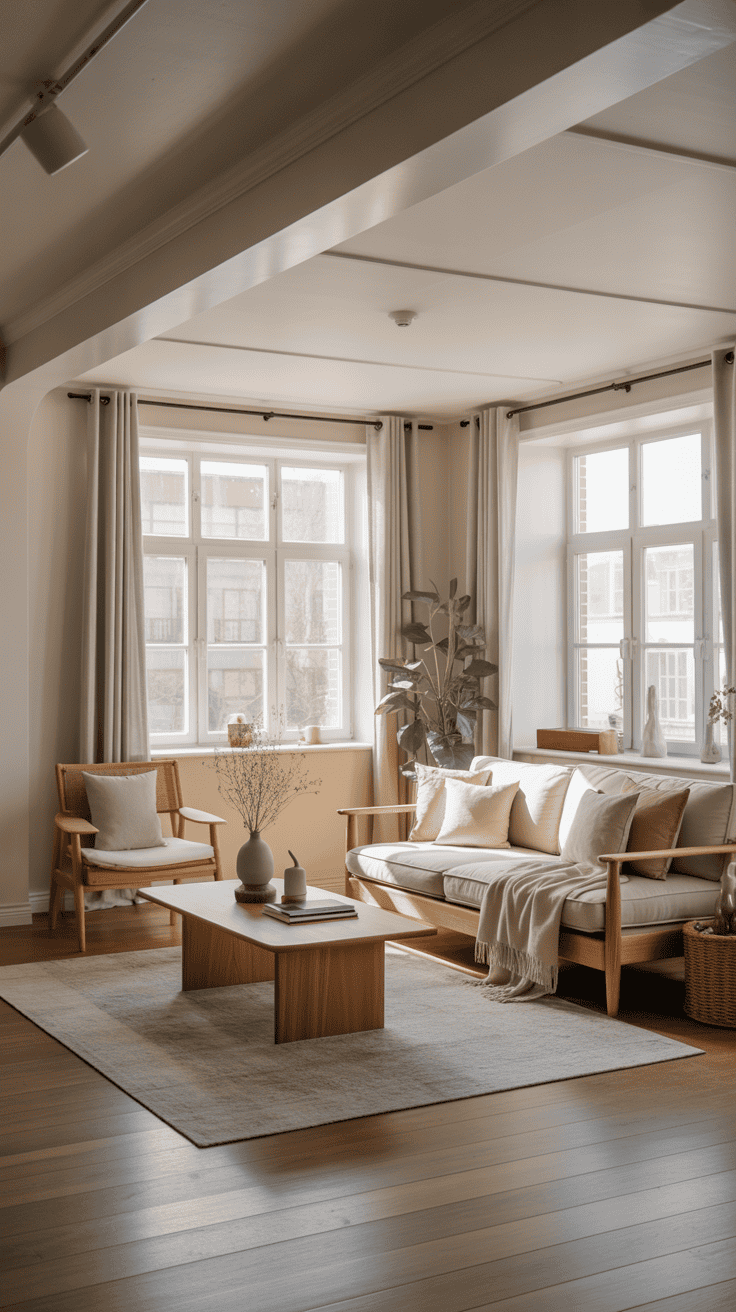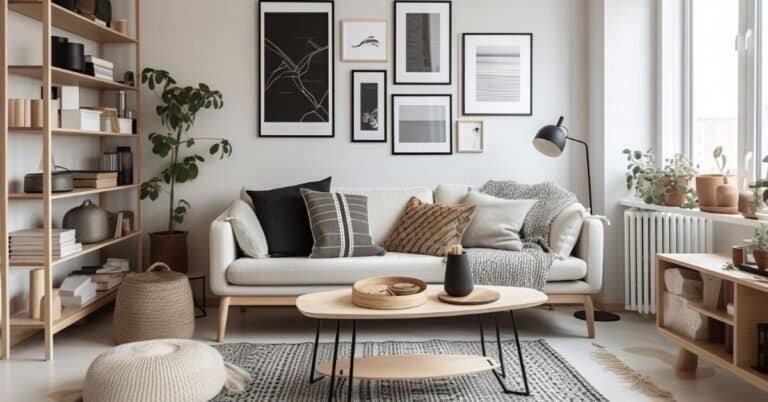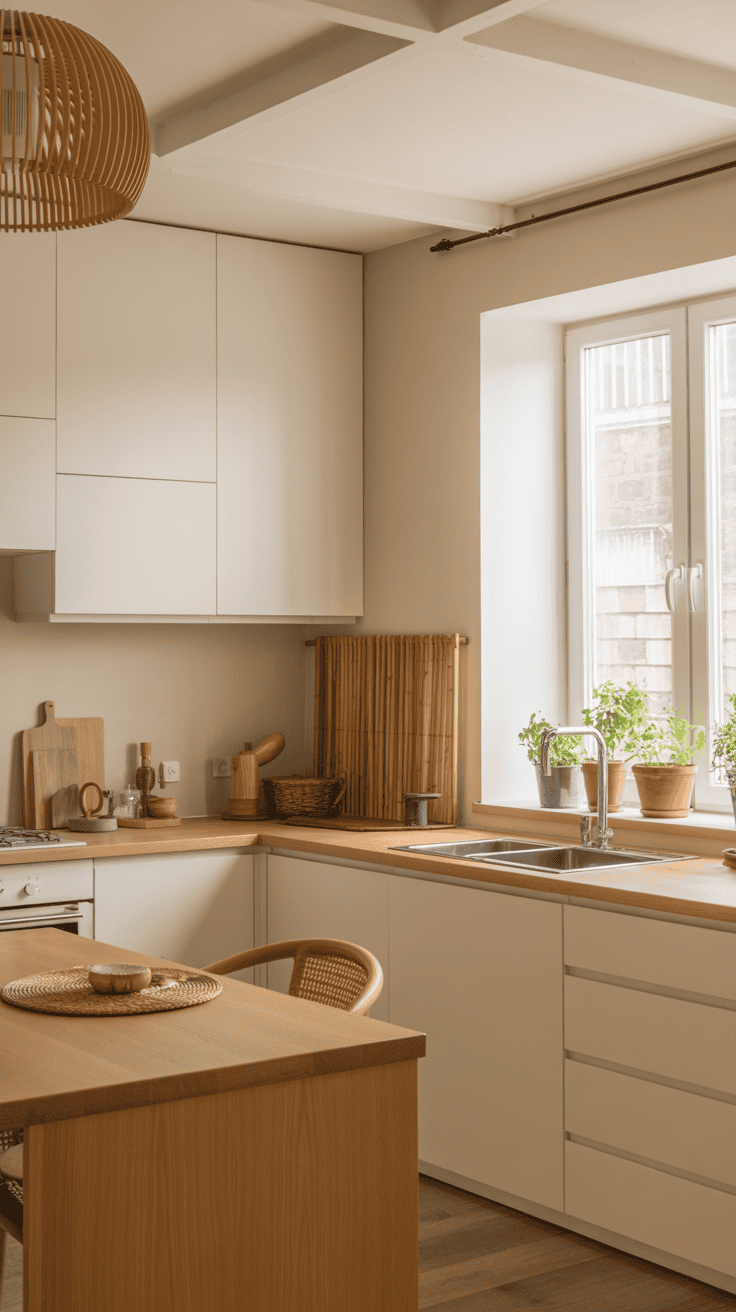This post shows 9 ways to create Japandi Interior Design Living Room!
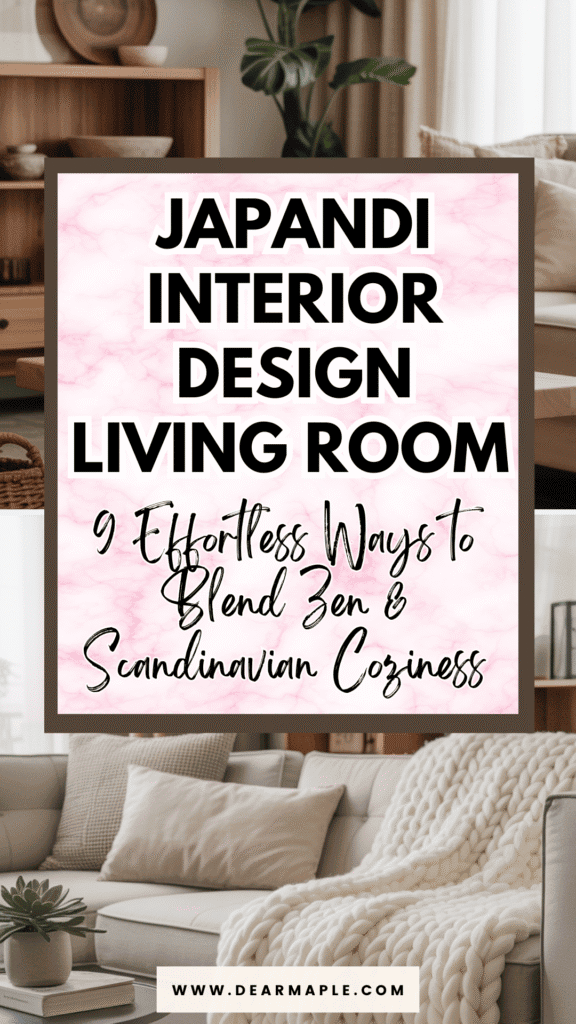
You know that feeling when you walk into a space and immediately exhale? That’s the magic of Japandi design—a gorgeous mashup of Japanese minimalism and Scandinavian hygge that creates living rooms so serene, you’ll wonder why you ever thought clutter was cool. I’ve been obsessed with this aesthetic for years, and trust me, it’s not just another design trend that’ll make you cringe in five years. This is timeless stuff that actually makes your life better.
9 ways to create Japandi Interior Design Living Room
1. Master the Neutral Color Foundation: Warm Beiges, Soft Grays, and Cream Whites

Let’s start with the backbone of any killer Japandi living room—the color palette. Forget about those Instagram-worthy rainbow walls because we’re going full zen here. Think warm beiges that remind you of morning coffee, soft grays like a cloudy Sunday, and cream whites that feel like a cozy blanket.
I learned this the hard way when I first attempted Japandi design. I went too cool with my grays and ended up with a living room that felt more like a doctor’s office than a sanctuary. The trick is finding those warm undertones that make neutral colors feel inviting rather than sterile.
Your walls should whisper, not shout. Paint them in warm white or the softest beige you can find. For accent colors, stick to mushroom grays, sage greens, or dusty blues—but use them sparingly. The goal is creating a backdrop that lets your furniture and natural elements shine without competing for attention.
Pro tip: Test your paint colors at different times of day. What looks perfect in afternoon light might feel cold and unwelcoming in the evening. I always tell people to live with paint samples for at least a week before committing. Your future self will thank you.
2. Choose Multi-Functional Furniture: Storage Ottomans and Convertible Coffee Tables

Here’s where Japandi design gets seriously practical. Multi-functional furniture isn’t just trendy—it’s brilliant. Why have a coffee table that only holds your drinks when it could also store your throw blankets, books, and that random collection of remotes we all seem to accumulate?
Storage ottomans are my personal heroes. They provide extra seating when friends drop by, double as footrests during Netflix marathons, and hide away all the stuff that would otherwise clutter your zen space. I’ve got one in natural linen that’s been through three moves and countless movie nights, and it still looks amazing.
Convertible coffee tables take this concept even further. Some expand for dinner parties, others lift to become laptop desks, and the really clever ones have hidden compartments for everything from board games to yoga mats. It’s like having furniture with superpowers.
When shopping for multi-functional pieces, prioritize quality over quantity. One well-made storage ottoman that lasts ten years beats three cheap ones that fall apart after a season. Look for solid wood construction, quality hardware, and fabrics that can handle real life—not just photo shoots.
3. Embrace Natural Materials: Raw Wood, Stone, and Woven Textures
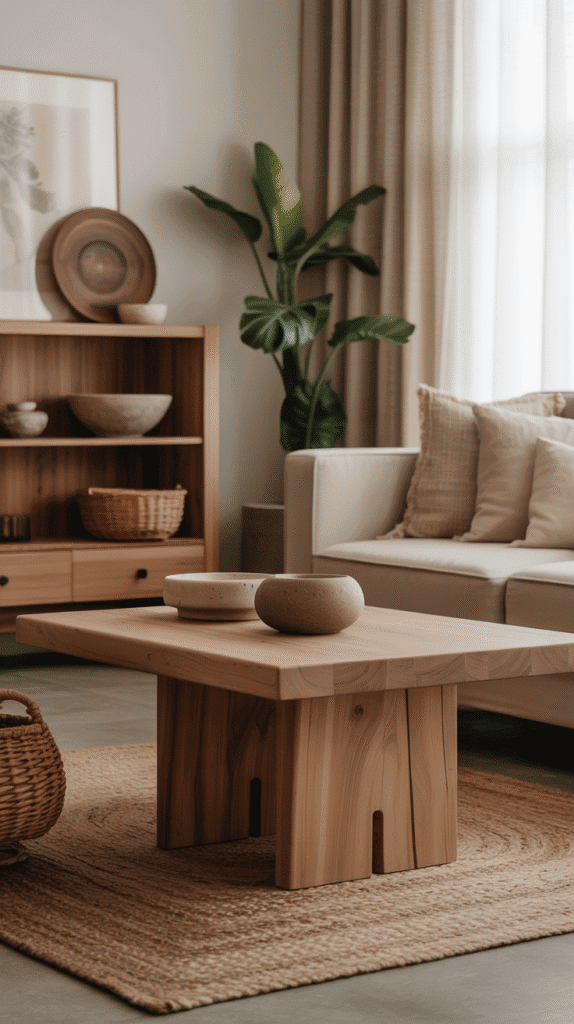
Ever notice how a walk in the forest instantly makes you feel calmer? That’s the power of natural materials, and Japandi design harnesses this connection beautifully. Raw wood, stone, and woven textures bring the outdoors in without making your living room look like a camping trip gone wrong.
Raw wood furniture is the star of the show here. I’m talking about pieces where you can see the grain, feel the texture, and maybe even spot a few natural imperfections that make each piece unique. Avoid anything too polished or perfect—we want character, not showroom perfection.
Stone elements add weight and grounding to your space. This doesn’t mean hauling boulders into your living room (though that would be memorable :)). Think stone-topped side tables, a beautiful ceramic lamp base, or even a simple stone bowl for your keys. These materials have this amazing ability to make a space feel rooted and peaceful.
Woven textures complete the natural trio. Jute rugs, rattan baskets, and linen cushions add visual interest without breaking the minimalist rule. They’re the perfect way to introduce pattern and texture while keeping things organic and calm.
4. Create Cozy Seating Areas: Floor Cushions and Oversized Throw Pillows
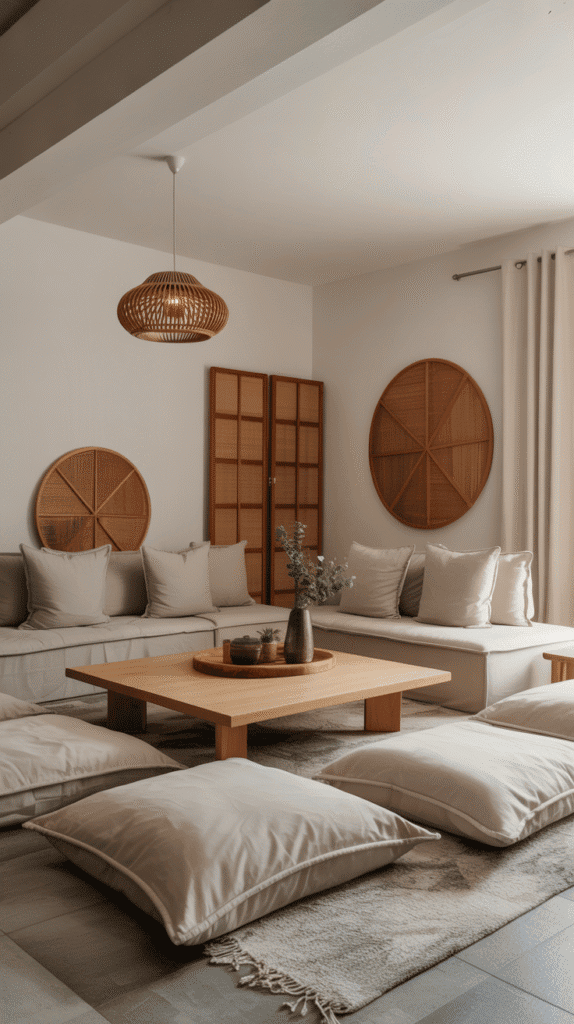
Time to get comfortable—literally. Floor seating might sound uncomfortable to anyone who’s spent years on traditional sofas, but trust me on this one. Floor cushions and oversized throw pillows create this incredibly intimate, relaxed vibe that makes everyone want to kick off their shoes and stay awhile.
I first experienced proper floor seating at a friend’s place in Tokyo, and it completely changed my perspective on how we use living spaces. There’s something about sitting closer to the ground that makes conversations more intimate and the whole room feel more connected.
Large floor cushions work beautifully around a low coffee table, creating an instant conversation pit. Look for high-quality filling that won’t flatten after a few uses—memory foam or down alternative work great. Cover them in natural fabrics like linen or cotton in your neutral palette.
Oversized throw pillows serve double duty as back support and impromptu seating. Stack them against walls or scatter them around your main seating area. The key is having enough that people can actually get comfortable, not just enough to look good in photos.
Don’t worry about creating a completely floor-based seating area if that’s not your thing. Even adding a few floor cushions to a traditional sofa setup instantly makes the space feel more relaxed and flexible.
5. Add Warmth with Soft Textiles: Chunky Knit Blankets and Linen Throws
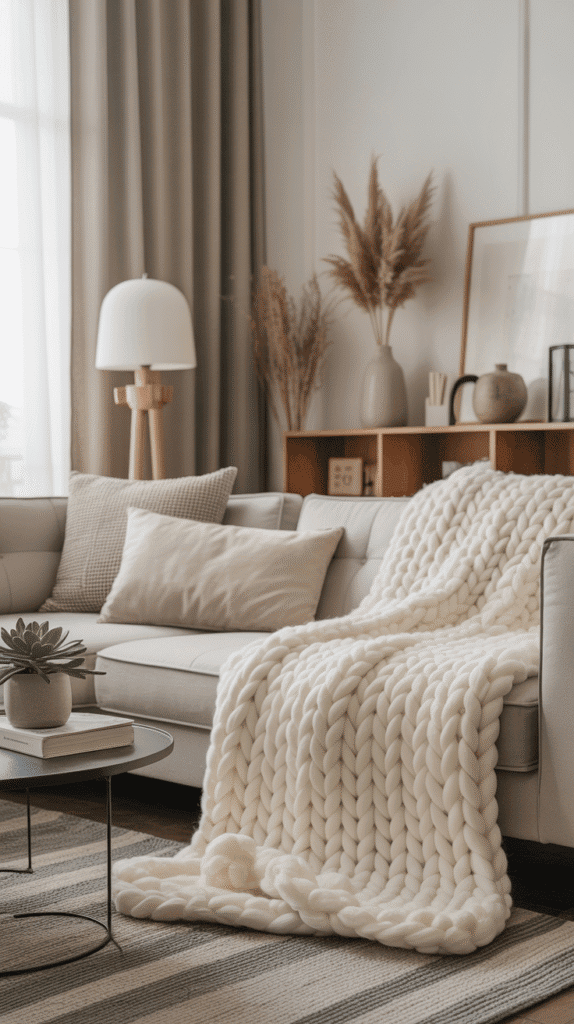
Nothing says “stay awhile” like a perfectly placed chunky knit blanket. Soft textiles are where Scandinavian coziness really shines in Japandi design. They’re your secret weapon for making a minimalist space feel warm and inviting instead of cold and stark.
Chunky knit blankets are basically hugs in fabric form. Drape one over your sofa, fold another at the foot of your daybed, or keep one in a basket for those spontaneous afternoon naps. Choose natural fibers like wool or cotton in your established neutral palette.
Linen throws add a different kind of texture—more relaxed and casual than chunky knits but equally cozy. I love how linen gets softer with every wash and develops this lived-in character that perfectly matches the Japandi aesthetic. Plus, it’s naturally temperature-regulating, so you won’t overheat during those summer movie marathons.
Layer different textures for maximum coziness. A smooth linen throw over a chunky knit blanket creates visual interest while providing options for different comfort levels. Some days you want the weight of wool, other days the lightness of linen.
Quality matters here more than quantity. One amazing blanket that you’ll actually use beats five mediocre ones that live in a closet. Feel the fabric, check the construction, and imagine how it’ll age. The best textiles get better with time, not worse.
6. Incorporate Mindful Lighting: Warm LED Bulbs and Ambient Table Lamps

Lighting can make or break your Japandi living room. Harsh overhead lighting is the enemy of zen, while warm, layered lighting creates that magical golden hour feeling all day long. I used to think one ceiling fixture was enough for any room—how wrong I was!
Warm LED bulbs are your foundation. Skip the cool white bulbs that make everything look like a hospital. Look for bulbs labeled “warm white” or “soft white” with a color temperature around 2700K. They use less energy than traditional bulbs while creating that cozy glow that makes everyone look better.
Ambient table lamps are where you can really have fun with Japandi style. Paper lanterns, ceramic bases, and wooden fixtures all work beautifully. I’ve got a simple ceramic lamp with a linen shade that provides the perfect reading light while adding sculptural interest to the room.
Consider adding dimmer switches to your existing fixtures. Being able to adjust brightness throughout the day means you can have energizing light for cleaning and soft ambiance for relaxing. It’s a small change that makes a huge difference in how your space feels.
Don’t forget about candles! They’re the ultimate mood lighting and add that flickering, living quality that no electric light can match. Plus, they’re basically meditation in a wick—the act of lighting them signals your brain to slow down and relax.
7. Display Carefully Curated Decor: Minimal Ceramic Pieces and Single Statement Plants

Here’s where Japandi design separates itself from basic minimalism—thoughtful curation. Every decorative element in your living room should earn its place through beauty, function, or meaning. This isn’t about having less stuff; it’s about having the right stuff.
Minimal ceramic pieces are perfect for this aesthetic. Think handmade bowls, simple vases, or sculptural objects that feel both modern and timeless. I have a small ceramic bowl that I picked up at a local pottery studio, and it’s become one of my favorite pieces—not because it’s expensive or famous, but because it’s beautifully made and serves a purpose.
When it comes to plants, quality over quantity is key. One stunning statement plant beats a collection of sad succulents every time. Fiddle leaf figs, monstera deliciosa, or a beautiful bonsai tree can anchor your space while bringing in that essential natural element.
The trick to displaying these pieces is giving them room to breathe. Don’t crowd objects together—let each piece have its moment. A single beautiful vase on a side table makes more impact than three smaller objects fighting for attention.
Remember, FYI, this is supposed to be a living space, not a museum. Choose pieces that you actually love looking at and interacting with, not just things that photograph well.
8. Establish Clear Zones: Designated Reading Nooks and Meditation Corners
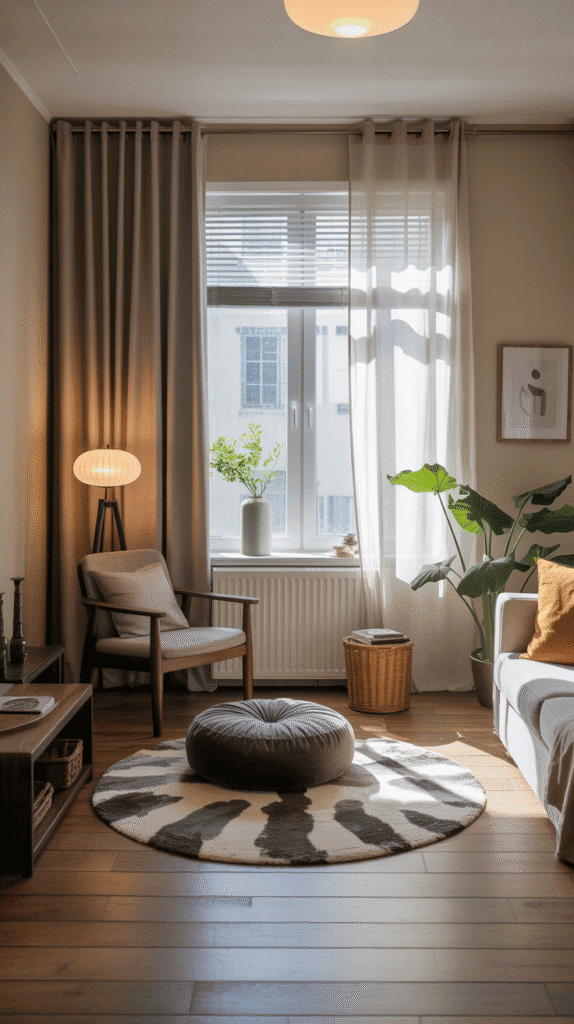
Intentional zoning is what transforms a regular living room into a Japandi sanctuary. Instead of having one big space that tries to do everything, create distinct areas for different activities. This makes your room feel larger and more purposeful.
A reading nook is basically mandatory in Japandi design. Find a corner with good natural light, add a comfortable chair or floor cushion, and include a small side table for your tea and books. I’ve created reading nooks in the tiniest apartments—sometimes it’s just a cushion by a window, but it signals to your brain that this is a space for slowing down.
Meditation corners serve a similar purpose but focus on mindfulness rather than entertainment. This could be as simple as a floor cushion facing a window, maybe with a small plant or candle nearby. The key is consistency—using the same spot regularly helps build the habit.
Don’t forget about conversation areas. Arrange seating to face each other rather than all pointing toward a TV. This encourages actual connection and makes the space feel more social and welcoming.
The goal is creating micro-environments within your living room that support different moods and activities. Some days you need to energize and focus, other days you need to relax and reflect. Good zoning supports both.
9. Maintain Visual Simplicity: Clean Surfaces and Intentional Empty Spaces

This is where Japandi design gets real about clutter. Visual simplicity doesn’t mean boring—it means every surface and space has breathing room. I used to think empty space was wasted space until I experienced the calm that comes from uncluttered surfaces.
Clean surfaces are non-negotiable. Coffee tables shouldn’t disappear under magazines, books, and random objects. Side tables shouldn’t become dumping grounds for mail and keys. This takes discipline (and good storage solutions), but the payoff is immediate.
Intentional empty spaces are just as important as the objects you choose to display. That blank wall section isn’t waiting for something to fill it—it’s providing visual rest for your eyes and brain. Negative space is a design element, not a problem to solve.
This doesn’t mean your living room should feel sterile or unlived-in. It means being thoughtful about what stays visible and what gets stored away. Daily tidying becomes a mindful practice rather than a chore when you have fewer objects to manage.
IMO, the hardest part of maintaining visual simplicity is resisting the urge to add more stuff. Every new object should be carefully considered: Does it serve a purpose? Does it bring joy? Does it fit the aesthetic? If not, it doesn’t belong.
Conclusion
Creating a Japandi living room isn’t about following a rigid set of rules—it’s about embracing a philosophy that values simplicity, natural beauty, and mindful living. These nine strategies work together to create spaces that feel both serene and lived-in, minimal yet cozy.
The best part? You don’t need to overhaul your entire living room overnight. Start with one element—maybe clearing your surfaces or adding some warm lighting—and build from there. Each small change brings you closer to that perfect blend of Zen tranquility and Scandinavian comfort.
Remember, the goal isn’t to create a picture-perfect showroom but to design a space that supports your actual life. A truly successful Japandi living room is one where you can relax, connect with others, and find peace in the everyday moments. And honestly? That sounds pretty amazing to me 🙂
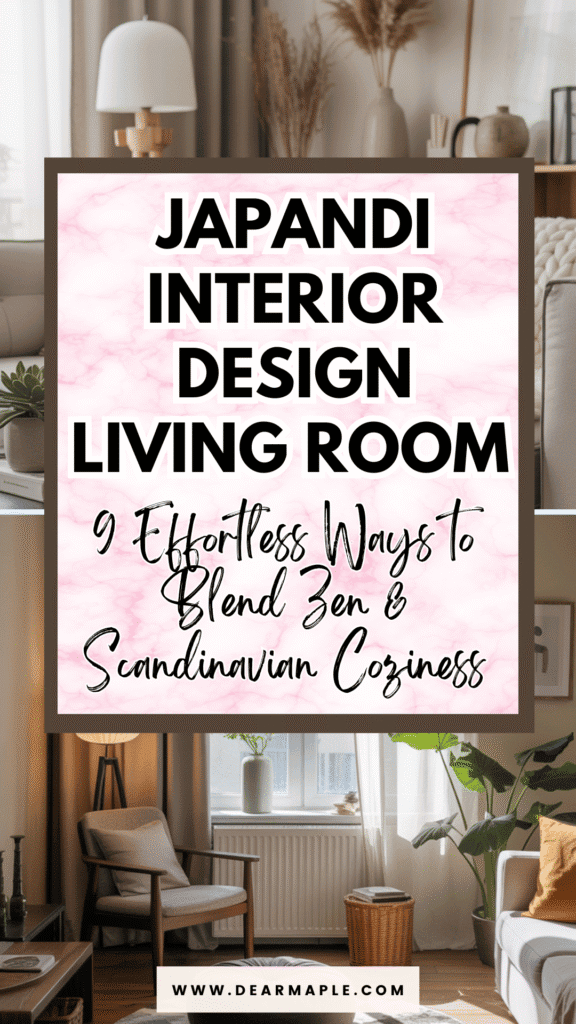
This post shows 9 ways to create Japandi Interior Design Living Room!

